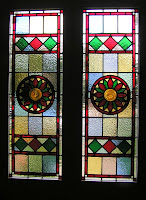Hand made glass leaded lights
 This pair of panels is made using hand-made glass (known as 'antique') - which is considerably more costly than the more commonly used machine or semi-machine made art glasses. Apart from the far more varied surface and the presence of small bubbles (seeds), the thickness of the glass varies, introducing subtle changes in colour, within the same piece of glass. This glass was fitted in June 2010 in an old Kentish farm house, which was undergoing extensive renovation. The brief was to produce some feature panels, whilst remaining sympathetic to the age of the building - hence the choice of this type of glass which is made in the ancient manner.
This pair of panels is made using hand-made glass (known as 'antique') - which is considerably more costly than the more commonly used machine or semi-machine made art glasses. Apart from the far more varied surface and the presence of small bubbles (seeds), the thickness of the glass varies, introducing subtle changes in colour, within the same piece of glass. This glass was fitted in June 2010 in an old Kentish farm house, which was undergoing extensive renovation. The brief was to produce some feature panels, whilst remaining sympathetic to the age of the building - hence the choice of this type of glass which is made in the ancient manner.Its interesting to note the differences in the appearance of the glass, against a neutral background, and from each side in the finished installation.
 The sandblasted work shown in the previous post, which is based on the badge of the original builders of the house, and which is present on the exterior walls can also be seen here, along with the Roman numerals for 2010, acknowledging the current restoration.
The sandblasted work shown in the previous post, which is based on the badge of the original builders of the house, and which is present on the exterior walls can also be seen here, along with the Roman numerals for 2010, acknowledging the current restoration.This was created by being re-drawn by an artist from a photograph of the original badge, scanning the drawing, cutting a plastic film 'resist', which is then applied to the glass prior to sandblasting












